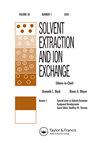Triflimide Effect in Solvent Extraction of Rare-Earth Elements from Nitric Acid Solutions by TODGA
IF 2.1
4区 化学
Q3 CHEMISTRY, MULTIDISCIPLINARY
引用次数: 0
Abstract
ABSTRACT Outer-sphere interactions play an important role in the liquid-liquid extraction and separation of metal ions and they could be used to tune the efficiency and selectivity of recovery. Here, we report the extraction behaviour and separation of trivalent rare-earth elements from aqueous nitric acid solutions with N,N,N’,N’-tetra-n-octyl diglycolamide (TODGA), which was preliminarily contacted with an aqueous solution of N-H acid bis[(trifluoromethyl)sulfonyl]imide (triflimide, HTf2N; Tf = CF3SO2) resulting in an adduct TODGA⋅HTf2N. We examined in detail the extraction system composed of TODGA acidified with HTf2N and 1,2-dichloroethane as diluent. The effect of various experimental conditions such as the nature of diluent, aqueous nitric acid concentration, and TODGA⋅HTf2N concentration in the organic phase was studied. It has been found that the distribution coefficient values for metal ions are much greater, especially at low aqueous acidity in the extraction systems with the acidified organic solvent phase. Furthermore, the heavier lanthanides were effectively extracted and the intergroup lanthanide selectivity was greatly improved (separation factors for the Lu/La pair increased by 40 and 2 times for the two systems under study, respectively).三氟氰胺对硝酸溶液中稀土元素溶剂萃取的影响
本文章由计算机程序翻译,如有差异,请以英文原文为准。
求助全文
约1分钟内获得全文
求助全文
来源期刊
CiteScore
4.40
自引率
5.00%
发文量
15
审稿时长
8.4 months
期刊介绍:
Solvent Extraction and Ion Exchange is an international journal that publishes original research papers, reviews, and notes that address all aspects of solvent extraction, ion exchange, and closely related methods involving, for example, liquid membranes, extraction chromatography, supercritical fluids, ionic liquids, microfluidics, and adsorption. We welcome submissions that look at: The underlying principles in solvent extraction and ion exchange; Solvent extraction and ion exchange process development; New materials or reagents, their syntheses and properties; Computational methods of molecular design and simulation; Advances in equipment, fluid dynamics, and engineering; Interfacial phenomena, kinetics, and coalescence; Spectroscopic and diffraction analysis of structure and dynamics; Host-guest chemistry, ion receptors, and molecular recognition.

 求助内容:
求助内容: 应助结果提醒方式:
应助结果提醒方式:


